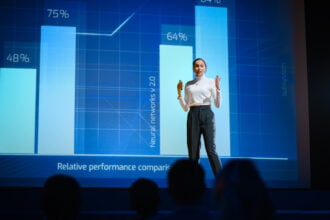More and more often, businesses are using data to drive their decisions — which makes cutting-edge analytics and business intelligence strategies one of the best advantages a company can have.
New technologies, especially those driven by artificial intelligence (or AI), are changing how businesses collect and extract usable insights from data.
Here are the six trends you should be aware of that will reshape business intelligence in 2020 and throughout the new decade.
1. New Avenues of Data Discovery
New data-collection technologies, like internet of things (IoT) devices, are providing businesses with vast banks of minute-to-minute data unlike anything collected before. Matt Turck, an AI and data investor, calls it “the ‘datafication’ of everything” — as more of the world comes online, it becomes possible to analyze, catalog and turn information into a format analysts, and AI, can break down.
These new avenues of data discovery will give business intelligence analysts more data sources than ever before.
At the same time, companies that handle massive amounts of data will need to start taking data security and privacy more seriously, especially if they’re handling confidential consumer information. Just as companies are becoming more aware of the value of data, so are hackers — and as a result, the frequency and cost of data breaches are beginning to skyrocket.
In the future, companies that come to rely on these new data sources will also need to protect that data — or risk the consequences.
2. AI-Powered Big Data Technology
Big data technologies allow data analysts to process vast amounts of data — more than any human analysts could ever hope to handle without the help of advanced AI technology.
As the amount of data collected by new technologies increases, business intelligence analysts may find there’s no way to sift through the amount of data they’re amassing.
Instead, they’ll turn to big data technology to help them work through and analyze this data.
3. Predictive Business Analytics
Some of these new tools use AI to predict events more accurately by employing predictive analytics to identify subtle relationships between even seemingly unrelated variables.
Predictive analytics is the use of data and AI-powered algorithms to help analysts forecast the future and better predict business outcomes.
AI-powered business intelligence tools can use predictive analytics and historic business data to anticipate shifts in market demand, emergent risks and other changes businesses will need to respond to.
While traditional business intelligence usually focuses on working with data to optimize current processes and reduce waste, with predictive analytics, business intelligence analysts can help companies future-proof workflows and business processes.
4. Natural Language Processing and Report Generation
New AI tools may also help you better collect and analyze text-based data and assist BI analysts in report creation.
Natural language processing — sometimes NLP, or conversational analytics, when applied to business intelligence — is an AI technique that trains computer software to process language in a way that models how humans read. NLP allows AI-driven technology to more flexibly and intelligently respond to language, which has posed a substantial problem for software-based solutions in the past.
Some major business intelligence platforms, like Microsoft’s Power BI and Tableau, have already integrated NLP features — like semantic search.
Semantic search functions allow non-subject matter experts to learn from data sets by posing questions in natural language. With these platforms, anyone can type in a query or request — like Microsoft’s example of “top-performing product by sales revenue” — and the platform will intelligently scan through the data, answer the question and provide insights for reporting.
NLP may also improve data collection by enabling AI to scan through and organize text-heavy, unstructured data.
One of the most significant challenges legacy data systems pose to AI-powered business intelligence is how often systems can silo off critical information or store it in formats that resist machine reading.
In most cases like these, analysts would need to perform the tedious work of going through hundreds or thousands of individual documents to collect the specific data points they needed. NLP may provide an answer to this challenge by being able to intelligently extract data from text-heavy documents.
5. The Growing BI Analyst Shortage
Like some other tech and STEM fields, business intelligence and data analytics are facing an increasing shortage of highly skilled analysts. There’s currently no sign this trend will reverse — and as AI-based technology becomes more widely adopted, and more businesses turn to AI-driven data collection and business intelligence, the shortage may even get worse.
It’s hard to tell if better education programs will improve the situation. Many experts believe current business intelligence and data analysis education programs aren’t effectively training their students to use AI-powered programs and other modern BI techniques.
At the same time, many of these business intelligence openings demand staff with years of experience in the field and high skill levels. Often, entry-level graduates won’t fit in these positions.
Your business may need to prepare for a shortage of business analysts and data scientists who are qualified to work with AI and big data.
6. General-Audience AI Tools
On the bright side, the tech industry may also have an AI-powered solution for the looming BI talent shortage.
Many BI platforms and tools are incorporating AI features designed for a general audience — even analysts and management members without experience working with AI or a data analytics background should be able to use them. These smarter tools can raise a company’s overall institutional IQ — possibly leading to higher sales and better cash flow.
These new tools may also help increase the speed of data collection and report generation, and allow anyone with access to the software to uncover new insights and data points that can drive business decision-making.
How Business Intelligence Will Change in 2020
It’s not quite the new oil, as some have argued, but data has almost certainly become one of the most valuable commodities a business can have.
AI-powered analytics tech isn’t likely to replace business intelligence analysts. Instead, it’s more likely to free up time for those analysts by automating tedious data collection process and by allowing management and team members without formal data training to answer simple questions.
In the future, data will likely become even more central to business intelligence. Most new technologies will rely, in one way or another, on AI. Business intelligence analysts will need to become familiar with AI-powered tools or risk being unable to work with the latest and most cutting-edge business intelligence tools.
At the same time, your company will need to prepare for a shortage of talented business intelligence analysts and managers who have data training.









